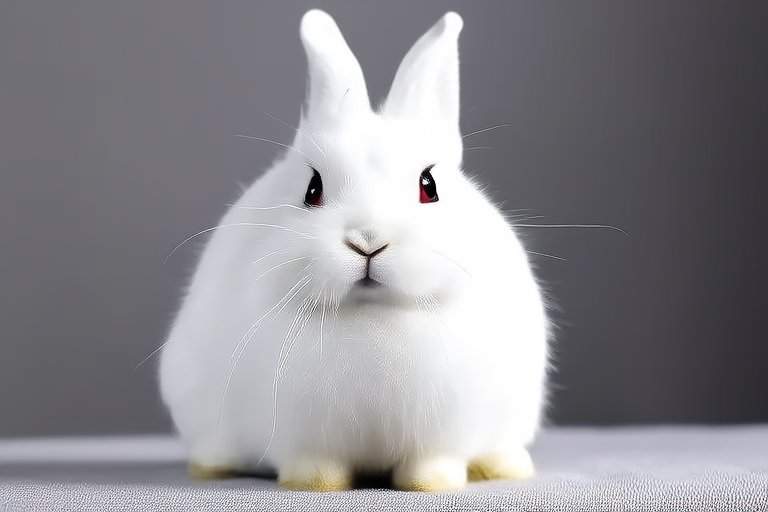
Hotot Rabbits: Why These Spots Make Them One of a Kind
The world of rabbits is vast and varied, with each breed offering something unique. Among the myriad of breeds, the Hotot rabbit stands out for its striking appearance and distinctive features. This article delves into the fascinating world of Hotot rabbits, exploring their unique physical characteristics, rich history, and why their spots make them truly one of a kind.
A Brief Overview of Hotot Rabbits
Hotot rabbits are small to medium-sized animals known for their stunning white fur and prominent black rings around their eyes, resembling mascara. Their bodies are compact and well-proportioned, making them both attractive and practical. The black eye-rings are one of the most defining features of the Hotot, giving them a striking and almost doll-like appearance. In addition to their eye-catching looks, Hotot rabbits also have strong legs and short, straight ears that add to their overall charm.
The History and Origin of the Hotot Rabbit
The Hotot rabbit breed was developed in France during the early 20th century by Eugenie Bernhard. Her goal was to create a rabbit that would have a pure white coat with perfect black eye-rings. To achieve this, she crossed the Blanc de Hotot (a rare breed known for its pure white fur) with other rabbit breeds, including the Checkered Giant and the Chinchilla. After years of selective breeding, Bernhard finally succeeded in producing the Hotot rabbit as we know it today. The breed was named after the town of Hotot-en-Auge in Normandy, where Bernhard lived and worked.
Why These Markings Set Hotot Rabbits Apart
The black eye-rings of the Hotot rabbit are not just aesthetically pleasing; they also serve a functional purpose. The contrast between the white fur and the black eye-rings makes it easier for the rabbit to see, as the dark color absorbs more light and helps protect the sensitive eyes from glare. Additionally, the presence of these distinct markings is significant in terms of genetics. The black eye-rings are the result of a recessive gene, which means that both parents must carry the gene for the offspring to inherit it. This genetic trait is what sets Hotot rabbits apart from other breeds and makes them highly sought after by breeders and enthusiasts alike.
Caring for Hotot Rabbits
Hotot rabbits require proper care to maintain their health and happiness. They need a clean, spacious living environment that provides ample room for movement and exercise. A wire cage or pen is ideal, as it allows for good air circulation and easy cleaning. The cage should be lined with soft bedding, such as straw or shredded paper, to ensure comfort and prevent pressure sores. It’s important to provide plenty of fresh water and a balanced diet that includes hay, pellets, and occasional treats like fruits and vegetables. Regular grooming is necessary to keep their white fur clean and free from debris.
Reproduction and Breeding
Breeding Hotot rabbits can be a rewarding but challenging endeavor. Female Hotot rabbits, or does, typically reach sexual maturity at around four to six months of age, while males, or bucks, may take slightly longer. When selecting breeding pairs, it’s essential to choose healthy, well-muscled rabbits with desirable traits, such as clear eye-rings and strong legs. Proper nutrition and regular veterinary check-ups are crucial during the breeding process to ensure the health of both the mother and the kits. Litters usually consist of three to five kits, which are born hairless and blind. Newborns require constant warmth and care until they are fully weaned at around eight weeks of age.
The Role of Hotot Rabbits in Petting and Agriculture
In recent years, Hotot rabbits have gained popularity as pets due to their docile nature and appealing appearance. They are often kept as companion animals and can be trained to perform simple tricks, making them entertaining and interactive companions. However, it’s important to note that owning a Hotot rabbit comes with responsibilities, and potential owners should be prepared to provide proper care and attention. While Hotot rabbits are primarily kept as pets, they can also play a role in agriculture. Their meat is considered a delicacy in some parts of the world, and they are sometimes raised for commercial purposes. However, the majority of Hotot rabbits are kept for show and companionship rather than for food production.
Encouraging Readers to Consider Adopting a Hotot Rabbit
If you’re considering adopting a Hotot rabbit, there are several factors to keep in mind. First and foremost, ensure that you have the time and resources to properly care for your new pet. Hotot rabbits require daily attention, including feeding, grooming, and social interaction. They also need a safe and comfortable living space that meets their specific needs. If you’re ready to take on the responsibility of caring for a Hotot rabbit, you’ll be rewarded with a loyal and affectionate companion. With their unique appearance and charming personality, Hotot rabbits make wonderful additions to any household.
In conclusion, Hotot rabbits are truly one of a kind, thanks to their distinctive white fur and black eye-rings. Their rich history and unique genetic makeup make them a fascinating breed to study and admire. Whether you’re interested in breeding, showing, or simply keeping one as a pet, Hotot rabbits offer a rewarding experience for those who appreciate their beauty and charm. So why not consider adding a Hotot rabbit to your family? With proper care and attention, you’ll be sure to enjoy many happy years with your new furry friend.




